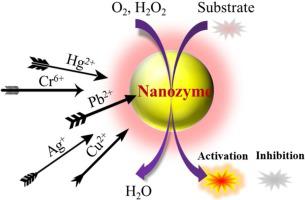Journal of Hazardous Materials ( IF 13.6 ) Pub Date : 2020-07-07 , DOI: 10.1016/j.jhazmat.2020.123397 Binesh Unnikrishnan,Chia-Wen Lien,Han-Wei Chu,Chih-Ching Huang

|
Large scale mining, manufacturing industries, exploitation of underground water, depletion of groundwater level, and uncontrolled discharge of industrial wastes have caused severe heavy metal ion pollution to the environment throughout the world. Therefore, the rapid detection of such toxic metal ions is inevitable. However, conventional methods require sophisticated instruments and skilled manpower and are difficult to operate in on-field conditions. Recently, metal nanozyme-based assays have been found to have the potential as an alternative to conventional methods due to their portability, simplicity, and high sensitivity to detect metal ion concentration to as low as parts per trillion (ppt). Metal nanozyme-based systems for heavy metal ions enable rapid and cheap screening on the spot with a very simple instrument such as a UV–vis absorption spectrophotometer and therefore, are convenient for use in field operations, especially in remote parts of the world. The sensing mechanism of a nanozyme-based sensor is highly dependent on its surface properties and specific interactions with particular metal ion species. Such method often encounters selectivity issues, unlike natural enzyme-based assays. Therefore, in this review, we mainly focus our discussion on different types of target recognition and inhibition/enhancement mechanisms, and their responses toward the catalytic activity in the sensing of target metal ions, design strategies, challenges, and future perspectives.
中文翻译:

基于金属纳米酶的重金属离子感测综述:挑战和未来展望。
大规模的采矿,制造业,地下水开采,地下水位枯竭以及工业废物的无控制排放已对全世界的环境造成了严重的重金属离子污染。因此,不可避免地需要快速检测这种有毒金属离子。然而,常规方法需要复杂的仪器和熟练的人力,并且难以在现场条件下操作。最近,由于基于金属纳米酶的检测方法具有便携性,简单性和高灵敏度,可检测到低至万亿分之一(ppt)的金属离子浓度,因此已被发现可以替代传统方法。基于金属纳米酶的重金属离子系统可使用非常简单的仪器(例如紫外可见吸收分光光度计)在现场进行快速且廉价的筛查,因此方便在现场操作中使用,尤其是在世界偏远地区。基于纳米酶的传感器的传感机制高度依赖于其表面性质以及与特定金属离子物种的特定相互作用。与基于天然酶的分析不同,这种方法经常遇到选择性问题。因此,在本综述中,我们主要将讨论重点放在不同类型的目标识别和抑制/增强机制上,以及它们对目标金属离子感测中的催化活性的响应,设计策略,挑战和未来展望。便于在现场操作中使用,尤其是在世界偏远地区。基于纳米酶的传感器的传感机制高度依赖于其表面性质以及与特定金属离子物种的特定相互作用。与基于天然酶的分析不同,这种方法经常遇到选择性问题。因此,在本综述中,我们主要将讨论重点放在不同类型的目标识别和抑制/增强机制上,以及它们对目标金属离子感测中的催化活性的响应,设计策略,挑战和未来展望。便于在现场操作中使用,尤其是在世界偏远地区。基于纳米酶的传感器的传感机制高度依赖于其表面性质以及与特定金属离子物种的特定相互作用。与基于天然酶的分析不同,这种方法经常遇到选择性问题。因此,在本综述中,我们主要将讨论重点放在不同类型的目标识别和抑制/增强机制上,以及它们对目标金属离子感测中的催化活性的响应,设计策略,挑战和未来展望。与基于天然酶的分析不同,这种方法经常遇到选择性问题。因此,在本综述中,我们主要将讨论重点放在不同类型的目标识别和抑制/增强机制上,以及它们对目标金属离子感测中的催化活性的响应,设计策略,挑战和未来展望。与基于天然酶的分析不同,这种方法经常遇到选择性问题。因此,在本综述中,我们主要将讨论重点放在不同类型的目标识别和抑制/增强机制上,以及它们对目标金属离子感测中的催化活性的响应,设计策略,挑战和未来展望。


























 京公网安备 11010802027423号
京公网安备 11010802027423号